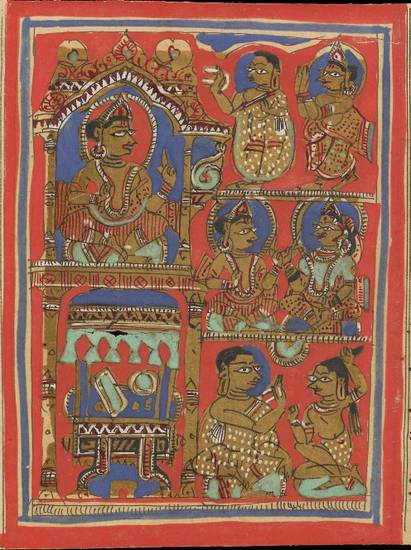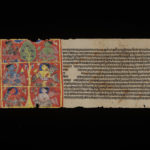Article: Karma
One of the most important concepts of the Jain religion, karma is closely connected to the other principal Jain theories of the soul – jīva – and the cycle of birth – saṃsāra.
Jain cosmology describes karma as a category of material – dravya – in the universe. It is a pudgala, which is an insentient, extremely fine physical matter. Characteristically, the Jains organise karma into numerous classes, mainly sorted according to their effects. The 148 types of karma may be negative or positive and may obscure the soul’s innate attributes or influence the body in which the soul is embodied.
All the karmas ‘bind to’ or infuse the soul. Once attached, karma’s relation to the soul is divided into six steps. The various karmas obscure the soul’s true nature or affect its embodiment. The impure, embodied soul takes on one of six colours or stains, depending on its karmas. The soul’s leśyā reflects spiritual purity, but does not affect the physical body or the soul itself.
Karma is both cause and effect of the soul’s embodiment. Karmas are generated by any activity, whether mental or physical, which are driven by feelings and responses to worldly concerns. Attachment and actions may be positive or negative, producing positive or negative karmas. The motive behind an action is also significant in creating positive or negative karma. Positive karmas result in rebirth as a god or human being whereas negative karmas cause rebirth as a being in hell or a being with limited reason, such as an insect or plant. Only human beings are able to reach salvation or liberation – mokṣa – but few humans achieve this incredibly difficult goal.
The karmas accrued over a lifetime trap the soul in the cycle of births. The karmas mature by affecting the soul or the physical body of its next lifetime or birth. When the body dies, the soul is born in a different body, which is shaped by karmas from the previous birth and the ones before that. The condition of the soul in that lifetime is also influenced by karmas from previous incarnations. This cycle of birth, death and life repeats endlessly while the soul has karmas attached to it.
The soul yearns to fulfil its true nature, which it cannot do while it is imprisoned within the cycle of rebirth. Only a soul without karma can be liberated from the cycle of birth, reaching self-realisation. Following the teachings of the Jinas and developing spiritually lead to the prevention of new karmas entering the soul – saṃvara – and the removal of existing karmas. Avoiding the creation of new karmas entails practising detachment from the world to a high level, which is extremely hard. Jains believe that only people who become mendicants can reach and maintain total detachment. Destroying karmas that are attached to the soul requires ascetic practices such as fasting, meditation and denying bodily needs and comforts. Observing such austerities needs self-control and self-awareness, which are instrumental to attaining complete detachment.
Jainism shares some features with other religions that developed in India, such as Buddhism and Hinduism. However, the concept of karma has been developed to the most detailed degree in the Jain faith.
Definition
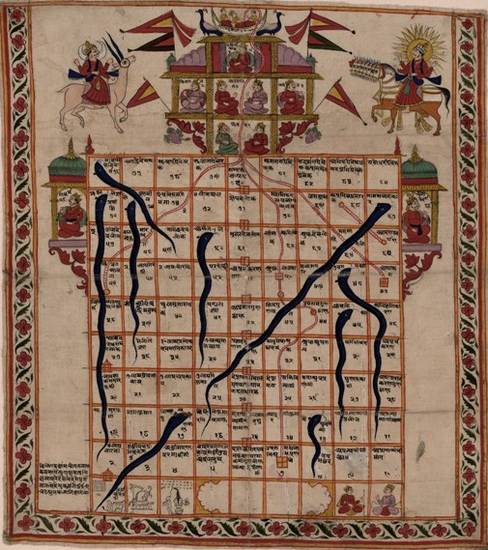
Snakes and ladders
Image by Victoria and Albert Museum © V&A Images/Victoria and Albert Museum, London
To Jains karma is a type of pudgala, which is an insentient, highly subtle matter that affects the soul. The concept of karma is very detailed and complex, with 148 types distinguished in Jain thought, based on their various effects. Some karmas are classed as destructive because of their deleterious effect on the soul‘s essential attributes. Other karmas are considered non-destructive because they affect the physical body in which the soul is embodied and do not inhibit spiritual development. All karmas have levels of intensity, depending on its cause and the other types of karmas present.
Karma has contact with the soul in six principal ways. When it matures or comes into effect, its influence lasts for a specific period of time. After this it falls away from the soul.
Types of karma
Jains organise karma into 148 distinct types, which are divided into eight main groups – mūla-prakṛtis. Each group produces different effects on fruition and is classed into the uttara-prakṛtis. Each type of karma is characterised by various elements, such as duration, intensity and quantity. Each sort of karma presents different aspects.
Destructive karmas
Of the eight main types of karma – mūla-prakṛtis – four types affect the innate qualities of the soul – guṇas – and are called ‘destructive’ – ghātiyā – karmas. A soul that has achieved omniscience – kevala-jñāna – is free of these four karmas.
|
Sanskrit term |
Details |
|---|---|
|
darśana-āvaraṇīya-karma |
Obscures the soul‘s perception – darśana |
|
Dampens the soul’s energy – vīrya – and:
|
|
|
Clouds the soul’s bliss – sukha – and:
|
Non-destructive karmas
Of the eight main types of karma – mūla-prakṛtis – four sorts influence the body within which the soul exists for a lifetime. They are called non-destructive – aghātiyā – karmas because they do not hinder the acquisition of:
These ‘three jewels’ of Jain doctrine can be reached and practised while the soul remains within the cycle of rebirth.
Because these types of karma affect the embodied soul, they are active while the soul is within a body, even if the soul becomes enlightened. When the body dies, these karmas fall away from the omniscient soul, thus allowing it to attain liberation.
|
Sanskrit term |
Details |
|---|---|
|
Sets the body’s:
|
|
|
Forms the body and physical attributes |
|
|
Determines the status of the body, for example high or low social status in the case of human beings |
|
|
Causes pleasant and unpleasant feelings |
Karma and the soul
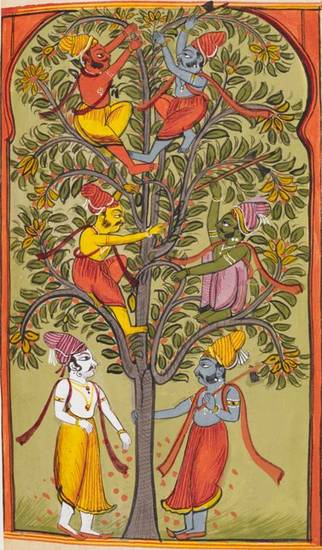
Parable of the tree
Image by British Library © CC0 1.0 (Creative Commons Public Domain)
One of the most significant and unique Jain beliefs, the notion of karma must be understood alongside another of the principal Jain concepts – that of the soul or self. In Jain cosmology karma is a very fine physical substance that becomes firmly attached to the soul – jīva. The various karmas permeate or ‘bind to’ the soul. Karmic contact with the soul can be divided into six stages. The different karmas corrode the soul or shape the physical body in which the soul is embodied and its circumstances. The soul’s spiritual development is affected by its karma, which can be evaluated by its colour. The pure soul is colourless, but when it is pervaded with karma it is coloured or stained. This leśyā can be used to assess its spiritual level.
In Jain thought the soul or self is a type of sentient, non-material matter – dravya – unlike other substances in the universe. Jains believe that karma is pudgala, which is an insentient, physical substance. The question of how a physical substance can attach to a non-material thing is not explained in Jain writings.
The table presents the stages of karma’s relationship with the soul.
|
Sanskrit term |
English rendering |
Details |
|---|---|---|
|
influx, entry |
karma enters the soul |
|
|
bondage |
the period after the karma enters the soul, during which it remains dormant |
|
|
udaya |
maturity, fruition, ripening |
when the karma comes into effect |
|
sattā |
existence |
the total length of time the karma is bound to the soul |
|
stopping the influx |
stopping the entry of karma to the soul |
|
|
separation, falling away |
the separation of existing karma from the soul |
Karma can be bound to the soul for a long time before it ripens, even lasting several lifetimes. Once it has come to fruition, karmic effects last for a certain time period. Following this, the karma falls away from the soul of its own accord.
In Jain belief karma obscures or covers the four essential qualities of the soul – guṇas – hampering their realisation. These innate attributes of perception, knowledge, energy and bliss each has a particular karma that affects it. These ‘destructive’ karmas – ghātiyā-karmas – are all negative because they cloud a particular soul quality and make it extremely difficult to make spiritual progress.
The karma stuck to the soul produces a karmic body – kārmaṇa-śarīra – that remains with the soul throughout its experiences in the cycle of births. The various karmas have fixed powers, dormancy and duration, and may mature many lifetimes after they were generated.
Leśyā
A soul’s level of spiritual development can be gauged by its leśyā. Produced by the interaction between karma and soul, leśyā is a staining of the soul, making it certain colours. These six colours indicate spiritual level and have no bearing on the colour of the body.
A perfect soul – siddha – has no karmas, so its inherent purity and clarity can be seen. As a soul develops spiritually, it gets lighter and brighter.
Causes of karma
The various kinds of karma are produced by activities. Karma is generated constantly, as long as any kind of activity is undertaken, including thought, because activity stems from the passions and emotions created by attachment to the world. Good actions bind beneficial types of karma – puṇya-prakṛtis – to the soul whereas bad actions bind negative karmas – pāpa-prakṛtis.
Activities, whether mental, emotional or physical, are motivated by passions – kaṣāyas – and emotions – no-kaṣāyas – which derive from attachment to worldly concerns. This includes affection for family and friends, interest in personal appearance and status, and concern for warmth, comfort and tasty food.
Intention is important in creating karma. Activity may be deliberate or inadvertent. Choosing to do something that accords with Jain principles is positive. Doing the right thing by mistake or out of habit is also positive but less so. Doing something against Jain principles because of absent-mindedness, accident or to protect or help others is negative but not as bad as deciding to do it. All these karmas are bound to the soul and usually take effect in later lives.
Effects of karma

Four types of existence
Image by Diwakar Prakashan / Padma Prakashan © Diwakar Prakashan / Padma Prakashan
The concept of the cycle of birth – saṃsāra – helps to explain the importance of karma in Jain doctrine. The various karmas created in one birth or lifetime influence different elements of the soul’s later embodiments. They may affect the soul itself or the body it has during that lifetime and in future births. As they are created by activities carried out during embodiment, karmas can therefore be understood as both cause and effect of the soul’s entrapment within the cycle of births.
In Jain belief the soul is embodied because it is bound with karmas and is impure. When the body dies, the soul is reborn into another body, according to the karmas it has produced. A soul is reborn many many times, over aeons, and cannot stop this repeating process of rebirth, which is the cycle of birth. Only a soul that has no karmas can be liberated from flesh, and can then realise its own perfection, which is called liberation – mokṣa. Over its numerous lifetimes in the cycle of birth the soul can make spiritual progress towards enlightenment, which is the step before liberation. However, it is an extremely long and difficult journey, with many pitfalls and setbacks.
The non-destructive – aghātiyā – karmas affect the physical body, its attributes, lifespan and general experiences. The destructive – ghātiyā – karmas alter the soul by hiding or hindering its essential qualities.
Broadly speaking, the bad activities generate negative karmas – pāpa-prakṛtis – while good activities produce positive karmas – puṇya-prakṛtis. ‘Bad’ behaviour goes against Jain doctrine, while ‘good’ conduct follows Jain principles.
Negative karmas, which include destructive karmas, lead to birth as spiritually devoid beings. These range from infernal creatures, animals and beings that lack the capacity for reason, such as less intelligent animals, plants or nigodas. Once embodied in such conditions, the soul finds it difficult to make spiritual progress and accrue positive karmas.
Positive karmas effect birth as an intelligent animal, god or human being. Although deities may have superhuman powers and have enjoyable lives free of care in the heavens, they are still souls caught in the cycle of rebirth. As beings with high intelligence and insight, they can develop spiritually quite far but cannot be liberated. Jains believe that only souls embodied in human beings are capable of reaching emancipation. Being human is therefore considered a rare and fortunate birth and is why human beings should do their best to work towards liberation, even if not all souls can achieve it within their first human incarnation.
Getting rid of karma
Removing karma from the soul is vital for reaching liberation – mokṣa. Exemplary Jain behaviour, such as avoiding violence and practising austerities, is therefore undertaken to stop karma forming or to eliminate it. New karma can be prevented from forming and entering the soul while existing karma can be annihilated. The 24 Jinas left guidance on how to do both, found in the Jain scriptures.
Blocking karma
Preventing karmas entering the soul is called saṃvara. Attachment to the world generates passions and emotions, provoking all kinds of activities, which cause the various kinds of karma. Therefore avoiding activity and maintaining absolute calmness at all times allows a soul to achieve saṃvara. Such calm can be attained only with total detachment from worldly affairs, which is extremely difficult to achieve.
In practice, Jains believe that such detachment requires renouncing the world to become a monk or nun. Jains who do not become mendicants can practise lesser degrees of detachment, such as limiting their possessions and trying not to become attached to them, meditating and remaining calm. Being able to reach saṃvara is a sign of advanced spiritual development.
Destroying karma
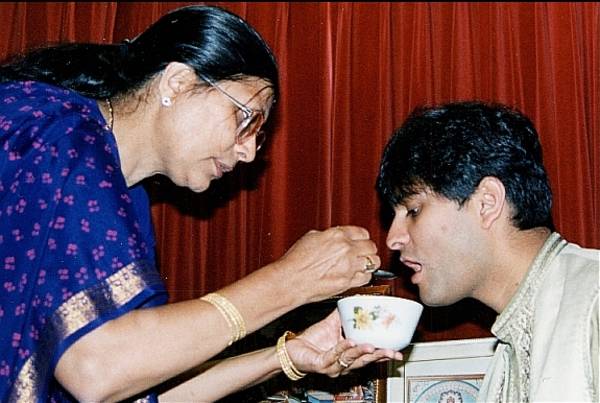
Completing a fast
Image by Chandu Shah © Chandu Shah
Jains can eliminate karmas in the soul by progressing spiritually. Karma can be destroyed by asceticism or austerities – frequently termed tapas – which eradicates the karma stuck to the soul. There are 12 sorts of austerities each for lay Jains and for mendicants. Since many austerities revolve around food practices, especially restrictions on food such as fasting, this indicates the importance of food in Jainism. Asceticism must be performed with the right religious attitude, which helps foster self-control and self-awareness. These qualities cultivate detachment, thereby connecting the two ways of stopping karma.
Religious austerities create bodily heat – properly called tapas – that burns away the karma permeating the soul. Ascetic practices may be either:
- external or physical
- internal or mental.
The texts detailing the conduct of ideal lay Jains – śrāvakācāras – describe recommended sorts of austerities. Similar writings on mendicant behaviour, such as the Uttarādhyayana-sūtra for Śvetāmbara orders, supply lists of austerities for monks and nuns.
Recommended ascetic practices for lay and mendicant Jains are summarised in the following tables.
|
|
Lay people |
|
|---|---|---|
|
1 |
fasting |
fasting – anaśana |
|
2 |
eating part of a meal |
limiting the quantity of food before feeling full – avamodarikā |
|
3 |
limiting the choice of food |
restrictions in gathering alms – bhikṣā-caryā |
|
4 |
rejecting delicacies |
avoiding tasty food, sauces and so on – rasa-parityāga |
|
5 |
avoiding temptation |
mortification of the flesh – kāya-kleśa |
|
6 |
subjecting the body to discomfort |
living in isolated places – saṃlīnatā |
Most of these austerities relate to food, especially the practice of fasting. These highlight the importance of food and fasting in both Jain doctrine and practice. Although there are numerous types of fast or limited eating, the most common kind of fasting among contemporary Jains is probably taking a vow to practise partial fasting or limited eating during festivals.
|
|
Lay people |
|
|---|---|---|
|
1 |
confession in the ritual of penitence – pratikramaṇa |
confession and repentance, which means atoning for sins and lapses – prāyaścitta |
|
2 |
respect for mendicants |
politeness or humility – vinaya |
|
3 |
service to mendicants |
serving the teacher and other senior monks – vaiyāvṛtya |
|
4 |
studying the scriptures – svādhyāya |
study – svādhyāyaa |
|
5 |
remaining perfectly still – kāyotsarga |
|
|
6 |
meditation – dhyāna |
‘rejection of the body’ – kāyotsarga, which means remaining motionless |
All austerities must be performed with the correct attitude of calm deliberation. Austerities that people undertake for wrong reasons, such as hoping to gain admiration from others, instead generate negative karmas.
All ascetic practices emphasise self-control and self-awareness, which aid the development of detachment. The two methods of karma removal are thus inter-related. Studying the scriptures and putting religious principles into practice are central to spiritual development in the Jain faith. Practical and conceptual frameworks such as the three gems and guṇa-sthāna help followers of the Jinas to both deepen their knowledge of Jain principles and practise them.
Indian religions and the soul
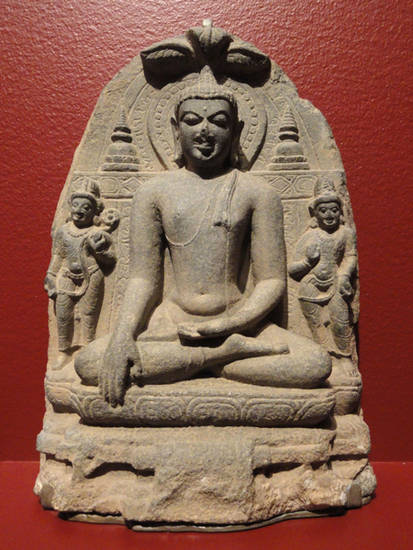
Buddha-SD-Mus Art-Daderot
Image by Daderot © public domain
Along with other religions that originated in India, such as Hinduism and Buddhism, Jains believe that souls:
- are trapped in the neverending cycle of rebirth – saṃsāra
- are reborn in different bodies according to the karma they have collected
- can only break out of the cycle of rebirth by being born a human being, achieving enlightenment and then, leaving the body behind, reaching liberation
- with karma attached to them can never be enlightened – the bondage of karma.
The Jain concepts of the soul and karma differ from those of the other Indian faiths, however. In Jainism souls are individual with the same innate qualities. They accrue karmas that are bound to them throughout the cycle of birth until they mature and fall away. Karma is a highly refined theory in the Jain religion, with 148 detailed classes of karma. Souls remain individual once they are perfected.
Followers of the Buddha do not believe in a soul in the same way as Jains and Hindus. The Buddha preached anatta – the doctrine of no soul – and that the cycle of birth involves a transfer of consciousness from one body to another, influenced by karma. Nirvāṇa is the term usually used for liberation or salvation – in which followers of the Buddha realise that there is neither self nor consciousness. It describes the extinguishing of the ‘fires’ of attachment, aversion and ignorance that cause suffering. Enlightened souls thus gain release from the cycle of births when they die – mokṣa – instead of another rebirth.
There is a variety of belief among Hindu traditions, although most Hindus believe in the soul or self – ātman – and liberation. Broadly, for Hindus ignorance of the true self or soul creates desire for and enjoyment of the world, which traps the soul in the cycle of birth. Karma comes from thoughts, words and deeds, and influences future lives. Between two births, the soul goes either to hell, to be punished for bad actions, or to heaven, where it enjoys rewards for good actions. Hindu mokṣa is the perfecting of the soul and release from the cycle of rebirths, although various schools differ on whether realisation of the soul can be achieved during or after life.
Reading
- Narrating Karma and Rebirth: Buddhist and Jain Multi-Life Stories
Naomi Appleton - Cambridge University Press; Cambridge, UK and New York, USA; 2014
- Karma
Johannes Bronkhorst - Dimensions of Asian Spirituality series
University of Hawaiʻi Press; Honolulu, Hawai'i, USA; 2011
- The Jains
Paul Dundas - Library of Religious Beliefs and Practices series; series editor John Hinnels and Ninian Smart; volume 14
Routledge Curzon Press; London, UK; 2002
- The Jaina Path of Purification
Padmanabh S. Jaini - University of California Press; Berkeley, California USA; 1979
- ‘Bhavyatva and Abhavyatva: a Jaina Doctrine of Predestination’
Padmanabh S. Jaini - Collected Papers on Jaina Studies
Motilal Banarsidass; New Delhi, India; 2000
- ‘Indian Perspectives on the Spirituality of Animals’
Padmanabh S. Jaini - Collected Papers on Jaina Studies
Motilal Banarsidass; New Delhi, India; 2000
- ‘From Nigoda to Mokṣa: The Story of Marudevī’
Padmanabh S. Jaini - Jainism and Early Buddhism in the Indian Cultural Context: Essays in Honor of Padmanabh S. Jaini
edited by Olle Qvarnström
Asian Humanities Press; Fremont, California, USA; 2003
- Harmless Souls: Karmic Bondage and Religious Change in Early Jainism with Special Reference to Umāsvāti and Kundakunda
William J. Johnson - Lala Sundar Lal Jain research series; volume 9
Motilal Banarsidass; Delhi, India; 1995
- Commentary on Tattvārtha Sūtra of Vācaka Umāsvāti
Pandit Sukhlalji - translated by K. K. Dixit
L. D. series; volume 44
L. D. Institute of Indology; Ahmedabad, Gujarat, India; 1974
- ‘The Story of King Śreṇika: Binding and Modification of Āyu Karma’
Kristi L. Wiley - Jainism and Early Buddhism in the Indian Cultural Context: Essays in Honor of Padmanabh S. Jaini
edited by Olle Qvarnström
Asian Humanities Press; Fremont, California, USA; 2003
- Historical Dictionary of Jainism
Kristi L. Wiley - Historical Dictionaries of Religions, Philosophies, and Movements series; series editor Jon Woronoff; volume 53
Scarecrow Press; Maryland, USA; 2004
- Jaina Yoga: A Survey of the Mediaeval Śrāvakācāras
Robert Williams - London Oriental series; volume XIV
Oxford University Press; London, UK; 1963
Links
- Doctrines of Jainism
-
In this chapter from his 1985 book, Paul Marett uses everyday language to explain the key points of Jain doctrine, including:
- karma
- soul
- five fundamental principles
- omniscience
- liberation.
The online version is available on the HereNow4U website.
- Karma
-
Chapter 4 of the 2006 book Introduction to Jainism, by Rudi Jansma and Sneh Rani Jain, describes the Jain theory of karma. The online version is presented on the HereNow4U website.
To move to the next page of the chapter, click on one of the arrows or slide the button along the scroll bar at the top and bottom of each page.
- Theory of Karma
-
Anop R. Vora briefly outlines the concept of karma within the Jain religion. The information is provided by the Jainism Literature Center, associated with the Faculty of Arts and Sciences at Harvard University.
http://www.fas.harvard.edu/~pluralsm/affiliates/jainism/article/karma.htm
- Karmavāda
-
Sadhvi Vishrut Vibha summarises the Jain concept of karma-vāda or karma in her 2007 book An Introduction to Jainism, provided on the HereNow4U website.
- The Doctrine of Karma in Jain Philosophy
-
HereNow4U presents chapter three of Bhagwaan Mahaveer Evam Jain Darshan, which discusses karma in Jainism. Originally written in Hindi by Mahavir Saran Jain in 2013, this book is translated into English by Pradyumna Shah Singh.
To move to another page, click on one of the arrows or slide the button along the scroll bar at the top and bottom of each page.
- Karmavād – Causality
-
In this chapter from his book Jainism: the Eternal and Universal Path for Enlightenment, Narendra Bhandari summarises the Jain theory of karma. HereNow4U provides this online version.
- Ashtakarma – Eight Types Of Karma
-
Manubhai Doshi outlines the types of karma in this chapter from Essence of Jainism, first published in 1992. The online version is on the HereNow4U website.
- Jain Karma Philosophy – Punya (Meritorious) and Pāp (Sinful) Karma
-
This article by Pravin K. Shah on the HereNow4U website explains some of the main classes of karma in Jain philosophy, namely:
- destructive – ghātiyā
- non-destructive – aghātiyā
- meritorious – puṇya
- bad – pāpa.
- Questions And Answers About The Theory Of Karma
-
Manubhai Doshi answers some common questions about karma in this chapter from Essence of Jainism, first published in 1992. The online version is on the HereNow4U website.
- The Doctrine
-
Colette Caillat, A. N. Upadhye and Bal Patil outline the central tenets of the Jain religion in this chapter from their 1974 work Jainism, including:
- the 'three gems'
- knowledge
- doctrine of 'truth from many viewpoints'
- tattvas
- soul
- karma
- leśyās
- cosmology
- cycles of time
- Jinas.
The online version is provided on the HereNow4U website.
- The Doctrine Of Karma – The Cycle Of Karma
-
In this chapter from The Quest For Truth: In the context of Anekanta, Ācārya Mahāprajña of the Śvetāmbara Terāpanth sect looks at the relationship between soul and karma. First published in 2003, the book is available online on the HereNow4U website.
To move to the next page of the chapter, click on an arrow or slide the button along the scroll bar at the top and bottom of each page.
- Where Will You Go? What Will You Be In Your Next Birth?
-
The text of a lecture delivered by Samani Prasanna Pragya in 2006 is presented on the HereNow4U website. In the lecture Samani Prasanna Pragya outlines the cycle of rebirth, karma and the classes of living beings.
- Theory Of Karma And Cycle Of Rebirth
-
Manubhai Doshi looks at the Jain concepts of karma and the cycle of rebirth in this chapter from Essence of Jainism, first published in 1992. The online version is on the HereNow4U website.
- Free Will and Karma
-
N. L. Kachhara describes the interplay of karma and the mind, focusing on the issue of free will and karma in Jain thought. This 2011 article is provided on the HereNow4U website.
- The Jaina Doctrine of Karma And The Science Of Genetics
-
This PhD thesis by Sohan Raj Tater examines how the Jain concept of karma relates to the science of genetics. The full text is available on the HereNow4U website.
- Jaina Doctrine Of Karma
-
In this 2005 book, N. L. Kachhara examines how the Jain doctrine of karma can be reconciled with the modern science of biology, especially genetics. The online version is on the HereNow4U website.
To move to the next page, click on an arrow or slide the button along the scroll bar at the top and bottom of each page.
- +
- aAbhavya
- aAbhinandana
- aAbhiṣeka
- aĀcāra
- aĀcārāṅga-sūtra
- aĀcārya
- aAchalbhrata
- aAḍhāī-dvīpa
- aAdharma
- aAdho-loka
- aAdhyayana
- aAdvaita Vedānta
- aĀgama
- aAghātīya
- aAghātīya-karman
- aAgnibhuti
- aAgra
- aĀhāra
- aAhiṃsā
- aAhimsa Day
- aAjita
- aAjīva
- aAkampit
- aĀkāśa
- aAkbar the Great
- aAkṣaya-tṛtīyā
- aAlauddin Khalji
- aAlbert Einstein
- aAllah
- aAlms
- aĀlocanā
- aAloka-ākāśa
- aAmāri
- aAmbikā or Kūṣmāṇḍinī
- aAnagāra
- aAnanta
- aAnarthadaṇḍa
- aAnaśana
- aAnekānta-vāda
- aAṅga
- aAniconism
- aAnojjā
- aAntarāla
- aAntarāya-karma
- aAṇu
- aAṇu-vrata
- aAnukampā
- aAnuprekṣā
- aAnusvāra
- aApabhraṃśa
- aAparigraha
- aAra
- aĀrambha
- aĀrambhaja
- aĀratī
- aArdhamāgadhī Prākrit
- aArhaṃ
- aArhat
- aArśana-āvaraṇīya-karma
- aĀrta-dhyāna
- aĀryikā
- aĀryikā Jñānamati
- aĀśātanā
- aĀścarya
- aAscetic
- aAsceticism
- aAshram
- aAspiration
- aĀsrava
- aAṣṭa-maṅgala
- aAṣṭāpada
- aAstikāya
- aAstrolabe
- aAsura
- aAtheism
- aAticāra
- aAtiśayakṣetra
- aAtithisaṃvibhāgavrata
- aĀtma-vāda
- aĀtman
- aAuṃ
- aAurangzeb
- aAuspicious
- aAusterity
- aAvadhāna
- aAvadhi-jñāna
- aĀvaraṇī-yakarman
- aAvasarpiṇī
- aAvatāra
- aAvidyā
- aAxiom
- aĀyāga-paṭa
- aĀyambil
- aĀyu-karma
- aĀyurveda
- bBabur
- bBāhubali
- bBaladeva
- bBālāvabodha
- bBandha
- bBasadi
- bBazaar
- bBhadrankarvijay
- bBhagavant
- bBhaktāmara-stotra
- bBhakti
- bBhale
- bBharata
- bBhāṣā
- bBhāṣya
- bBhaṭṭāraka
- bBhāva
- bBhāva-pūjā
- bBhāvanā
- bBhavana-vāsin
- bBhavya
- bBhavyatva
- bBhaya
- bBhoga-bhūmi
- bBhogopabhoga
- bBodhi
- bBollywood
- bBrahmā
- bBrahma-deva
- bBrahmacārī
- bBrāhmaṇa
- bBraj Bhāṣā
- bBright fortnight
- bBritish Raj
- bBuddha
- bBuddhi-sagar
- bBuddhism
- bBuddhist
- cCaitya
- cCaityavāsin
- cCakravartin
- cCakreśvarī
- cCāmara
- cCandanā
- cCandragupta
- cCandraprabha
- cCanon
- cCāritra
- cCāritramohanīya-karman
- cCarũrī
- cCaste
- cCaturvidha-saṅgha
- cCaturviṃśati-stava
- cCāturyāma
- cCE
- cCelibacy
- cCha
- cChadmastha
- cChastity
- cCheda-sūtra
- cChristian
- cChristianity
- cClergy
- cCloning
- cColophon
- cCommentary
- cConch
- cConfession
- cCongregation
- cConsecration
- cCosmology
- cCremation
- cCrore
- cCult
- cCūrṇi
- dDādā-guru
- dDalit
- dDāna
- dDaṇḍa
- dDark fortnight
- dDarśana
- dDarśanamohanī-yakarman
- dDaśa-lakṣaṇa-parvan
- dDeity
- dDelhi Sultanate
- dDerāsar
- dDeśāvakāśika-vrata
- dDetachment
- dDevanāgarī
- dDevānandā
- dDevarddhi-gani
- dDevotee
- dDhamal
- dDhanuṣ
- dDhāra
- dDharma
- dDharma-dhyāna
- dDharma-sāgara
- dDharmastikaya
- dDhātakīkhaṇḍa
- dDholak
- dDhyāna
- dDiaspora
- dDig-vrata
- dDigambara
- dDīkṣā
- dDisciple
- dDīvālī
- dDivya-dhvani
- dDNA
- dDoctrine
- dDogma
- dDonor
- dDoṣa
- dDravya
- dDravya-pūjā
- dDrone
- dDuṣamā
- dDuṣamā-duṣamā
- dDuṣamā-suṣamā
- dDveṣa
- dDvīpa
- eEast India Company
- eEightfold Path
- eEkānta-vāda
- eEkendriya
- eElder
- eElders
- eEschatology
- eEtc up to
- fFarmān
- fFast
- fFatehpur Sikri
- fFestival
- fFestschrift
- fFiruz Shah
- fFly-Whisks
- fFolio
- fFour Noble Truths
- gGaccha
- gGaṇa
- gGaṇadhara
- gGanadharavada
- gGaṇeśa
- gGaṇin
- gGarba
- gGarbha
- gGarbha-gṛha
- gGaruḍa
- gGati
- gGene
- gGenomics
- gGhātī-yakarman
- gGhātīya
- gGhaznavid
- gGhiyasuddin Tughlaq
- gGhurid
- gGloss
- gGotra-karma
- gGujarāt
- gGujarati
- gGuṇa
- gGuṇa-sthāna
- gGuṇa-vrata
- gGupti
- gGuru
- gGuruṇī
- hHagiography
- hHajj
- hHaṃsa
- hHaribhadra
- hHariṇaigameṣin
- hHasta
- hHeresy
- hHiṃsā
- hHindi
- hHindu
- hHinduism
- hHīravijaya
- hHoroscope
- hHrīṃ
- hHumayun
- hHymn
- iIconoclasm
- iIconography
- iIdol
- iIndian Independence
- iIndology
- iIndra
- iIndrabhūti Gautama
- iIndriya
- iInitiation
- iIntercession
- iInvocation
- iIQ
- iIslam
- iIslamicate
- iIṣṭadevatā
- iĪśvara
- jJagat
- jJahangir
- jJain
- jJaina Devanāgarī
- jJaina Śaurasenī
- jJaina-dharma
- jJainaśāsana
- jJainness
- jJaisalmer
- jJamāli
- jJambū-dvīpa
- jJames Burgess
- jJanma
- jJanma-kalyāṇa
- jJarā
- jJāti
- jJina
- jJina-āgama
- jJina-bhavana
- jJina-bimba
- jJina-mātā
- jJinacandra-sūri
- jJinadatta
- jJinaprabha
- jJīva
- jJñāna
- jJñāna-āvaraṇīya-karma
- jJñāna-āvarṇiya
- jJñānsundar
- jJyotiṣka
- kKāla
- kKālakācārya-kathā
- kKālidāsa
- kKalpa-sūtra
- kKalpa-vṛkṣa
- kKalyāṇaka
- kKalyanvijay
- kKamaṇḍalu
- kKamaṭha
- kKarma
- kKarma-bhūmi
- kKarma-grantha
- kKarma-prakṛti
- kKarma-vāda
- kKarmon
- kKarnataka
- kKaṣāya
- kKathā
- kKāvya
- kKāya
- kKāyotsarga
- kKeśa-loca
- kKetu
- kKevala-jñāna
- kKevalin
- kKhalji
- kKharatara-gaccha
- kKnowledge
- kKriyā
- kKriyā-vāda
- kKṛṣṇa
- kKṣamā-śramaṇa
- kKṣapakaśreṇi
- kKṣatriya
- kKṣullaka
- kKulakara
- kKundakunda
- kKunthu
- lLabdhi
- lLaity
- lLakh
- lLāñchana
- lLands of Action
- lLaukāntika
- lLavaṇa-samudra
- lLeśyā
- lLiṅga
- lLinguistics
- lLoka
- lLoka-ākāśa
- lLoka-puruṣa
- lLoka-vāda
- lLotus
- lLotus lake
- mMadhya-loka
- mMahā-videha
- mMahā-vrata
- mMahābhārata
- mMahāmastakābhiṣeka
- mMāhārāṣṭra
- mMāhārāṣṭrī Prākrit
- mMahattarā Yākinī
- mMahāvīr Jayantī
- mMahāvīra
- mMakāra
- mMakkhali Gośāla
- mMalli
- mMāna-stambha
- mManaḥ-paryāya-jñāna
- mMaṇḍala
- mMaṇḍapa
- mMandit
- mMaṅgala
- mMantra
- mMantras
- mManuṣya-loka
- mMarāṭhī
- mMārgaṇā
- mMartyr
- mMarudevī
- mMaṭha
- mMati-jñāna
- mMauryaputra
- mMecca
- mMendicant lineage
- mMetarya
- mMiracle
- mMithyādṛṣṭi
- mMohandas Gandhi
- mMohanīya-karma
- mMokṣa
- mMonastic order
- mMonasticism
- mMonk
- mMonotheism
- mMosque
- mMount Meru
- mMount Sammeta
- mMṛgāvatī
- mMughal
- mMuhammad
- mMuhammad bin Tughlaq
- mMuhpattī
- mMūla-sūtra
- mMūlaguṇa
- mMumbaī
- mMuni
- mMunisuvrata
- mMurad Bakhsh
- mMūrti-pūjaka
- mMuslim
- mMysticism
- nNābhi
- nNāga-kal
- nNāgapurīya Tapā-gaccha
- nNāgarī
- nNāma-karma
- nNamaskāra-mantra
- nNami
- nNandīśvara-dvīpa
- nNandivardhana
- nNandyāvarta
- nNāraka
- nNāraki
- nNasalisation
- nNātha
- nNavrātrī
- nNaya-vāda
- nNemi
- nNidāna
- nniggaṃthāṇa vā 2
- nniggaṃtho vā 2
- nNigoda
- nNihnava
- nNikṣepa
- nNirgrantha
- nNirjarā
- nNirvāṇa
- nNiryukti
- nNiṣidhi
- nNitya
- nNiyati
- nNo-kaṣāya
- nNudity
- nNun
- oOcean of milk
- oOmniscience
- oOrdination
- ppa°
- pPadmaprabha
- pPadmāsana
- pPadmāvatī
- pPādukā
- pPalanquin
- pPalette
- pPañca-muṣṭi
- pPāṇḍava
- pPaṇḍit
- pPandit Dalsukh D. Malvania
- pPandit Sukhlalji
- pPāṇipātra
- pPāpa
- pParamātman
- pParameṣṭhin
- pPāraṇā
- pParigraha
- pPariṇāma
- pParīṣaha
- pParokṣa
- pPārśva
- pPārśvanātha
- pParyāya
- pParyuṣaṇ
- pPaṭa
- pPatan
- pPātra
- pPenance
- pPersian
- pPhala
- pPhilology
- pPicchikā
- pPilgrimage
- pPīr
- pPolymath
- pPoṣadha
- pPossession
- pPothī
- pPrabhas
- pPradakṣiṇā
- pPradeśa
- pPrākāra
- pPrakīrṇaka-sūtra
- pPrākrit
- pPramāda
- pPramukhā
- pPrati-vāsudeva
- pPratikramaṇa
- pPratimā
- pPratiṣṭhā
- pPratyākhyāna
- pPratyakṣa
- pPravacana
- pPrāyaścitta
- pPrayer
- pPre-modern
- pPreach
- pPredestination
- pProtestant
- pProvenance
- pPudgala
- pPūjā
- pPujārī
- pPukharavara-dvīpa
- pPuṇya
- pPūrva
- pPuṣkara-dvīpa
- pPuṣpadanta
- pPyre
- qQur’an
- rRāga
- rRāhu
- rRainy season
- rRajasthan
- rRajasthani
- rRājimatī
- rRajoharaṇa
- rRajput
- rRāma
- rRāmāyaṇa
- rRangoli
- rRās-garbā
- rRasa
- rRathanemi
- rRatna-traya
- rRātri-bhojana
- rRaudra-dhyāna
- rRecto
- rRelic
- rRenunciation
- rRetroflex
- rRevatī
- %Ṛg-veda
- rRite
- rRosary
- %Ṛṣabha
- %Ṛṣabhanātha
- rRupee
- sSaciyā Mātā
- sSādhu
- sSādhvī
- sSāgāra
- sSaint
- sŚaivaism
- sŚaka-saṃvat
- sSallekhanā
- sŚalya
- sSamacatuṣṭha
- sSamādhimaraṇa
- sSamaṇi
- sSāmarambha
- sSamavasaraṇa
- sSāmāyika
- sSaṃbhava
- sSamiti
- sSaṃjñā
- sSaṃkalpaja
- sSaṃsāra
- sSamudghāta
- sSaṃvara
- sSaṃvega
- sSamyak-cāritra
- sSamyak-darśana
- sSamyak-jñāna
- sSamyaktva
- sSaṃyama
- sSanctuary
- sSandalwood
- sSaṇgha
- sSanskrit
- sSant
- sŚānti
- sSapta-bhaṅgi-naya
- sSārambha
- sSarasvatī
- sSarvajña
- sSāsan-devi
- sŚāsana-devatā
- sŚāstra
- %Ṣaṭ-jīvanikāya
- sSatī
- sSatīmātā
- sSatya
- sSchism
- sScribe
- sScripture
- sSect
- sSecularism
- sŚenāī
- sSermon
- sŚeṣavatī
- sSevā
- sSeven fields of donation
- sShah Jahan
- sShantidas Jhaveri
- sShrine
- sSiddha
- sSiddha-śilā
- sSiddhacakra or Navadevatā
- sSiddhānta
- sSiddhārtha
- sSiddhi
- sSikh
- sSikhism
- sŚikṣā-vrata
- sŚīla
- sSin
- sSindh
- sŚītala
- sŚiva
- sSkandha
- sSomanatha
- sŚraddhā
- sŚramaṇa
- sŚrāvaka
- sŚrāvakācāra
- sŚrāvikā
- sŚreyāṃsa
- sŚrī
- sŚrīvatsa
- sŚruta-jñāna
- sŚruta-pañcamī
- sSthānaka-vāsin
- sSthāpanācārya
- sSthāvara
- sSthavira
- sSthiti
- sStrīmukti
- sStūpa
- sSubcontinent
- sSudarshana
- sŚuddhi
- sSudharma
- sŚūdra
- sSufism
- sSukha
- sŚukla-dhyāna
- sSulasā
- sSultan
- sSumati
- sSundarśrī
- sSupārśva
- sSūri
- sSuṣamā
- sSuṣamā-duṣamā
- sSuṣamā-suṣamā
- sSūtra
- sSuyam me ausam! Tenam bhagavaya evamakkhayam
- sSvādhyāya
- sSvāhā
- sSvastika
- sŚvetāmbara
- sŚvetāmbara Terāpanthin
- sŚvetāmbaras
- sSwan
- sSyād-vāda
- tTabla
- tTantra
- tTapā-gaccha
- tTapas
- tTāraṇ Svāmī Panth
- tTattva
- tTattvārtha-sūtra
- tTemple
- tTemple-city
- tThe Enlightenment
- tTheology
- tThree worlds
- %Ṭīkā
- tTilaka
- tTīrtha
- tTīrthaṃkaranāma-karman
- tTīrthankara
- tTransliteration
- tTrasa
- tTrasa-nāḍī
- tTriśalā
- tTriṣaṣṭi-śalākā-puruṣa-caritra
- tTti bemi
- tTughlaq
- tTunk
- uUdumbara
- uUniversal History
- uUpādhyāya
- uUpāṅga
- uUpaniṣads
- uUpāsaka
- uUpasarga
- uUpāśraya
- uŪrdhva-loka
- uUtsarpiṇī
- uUttarādhyayana-sūtra
- vVāhana
- vVaimānika
- vVairāgya
- vVaiṣṇava
- vVaiśramaṇa
- vVaiśya
- vValabhī
- vVanaspatikāya
- vVandana
- vVaṇik
- vVarṇa
- vVāsudeva
- vVāsupūjya
- vVayubhūti
- vVeda
- vVedanīya-karma
- vVegetarianism
- vVehicle
- vVernacular
- vVerso
- vVidyā
- vVidyā-devī
- vVihāra
- vVijñapti-patra
- vVikrama-saṃvat
- vVikṛti
- vVimala
- vVinaya
- vVipāka
- vVirji Vora
- vVirodhaja
- vVīrya
- vVisarga
- vViṣṇu
- vVītarāga
- vVizier
- vVotive
- vVow
- vVrata
- vVS
- vVyakta
- vVyantara
- vVyasana
- yYakṣa
- yYakṣī
- yYantra
- yYaśoda
- yYaśovijaya
- yYati
- yYātrā
- yYoga
- yYoginī
- yYojana


